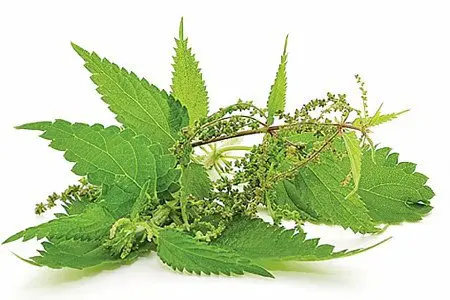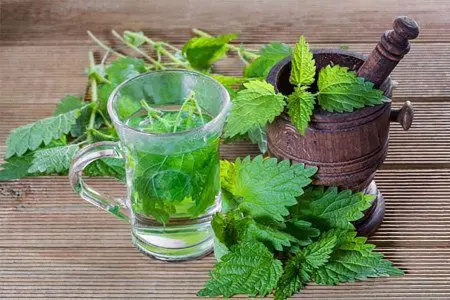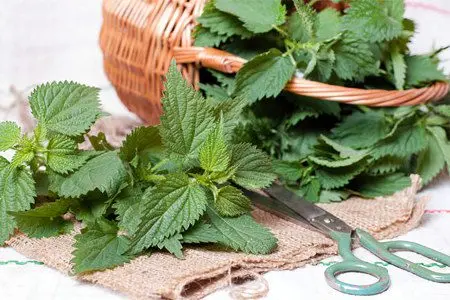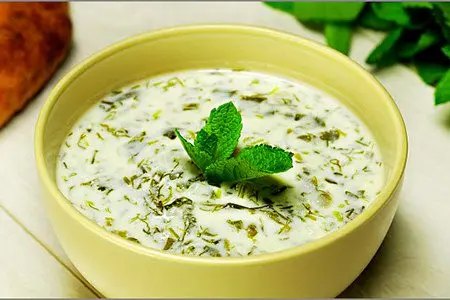Contents
Stinging nettle is probably known to every person. Nondescript, burning, medicinal, tasty – all this is about nettles. It has entered into the everyday life of man since the time of Ancient Rome. The finest fabrics were made from nettles, medicinal compositions, magic potions were prepared and eaten. Acquaintance with this amazing plant occurs, as a rule, in childhood and is unpleasant. Only with age does a person realize the full value of nettle.
Nettle – what is this plant?

Nettle is a rather nondescript plant that can reach a height of up to 100-120 cm. It differs little from other weeds – petiolate ovoid leaves with large teeth are located on a thick stem. Small greenish-white flowers are collected in tiny spikelets, which are located in the axils of the leaves. Due to its modest appearance, the nettle is lost among the weeds and does not attract attention to itself.
Nettle is common on continents with a temperate and subtropical climate. In Russia, it can be found even in Kamchatka and Sakhalin. Nettle feels great high in the mountains, forests, gardens, swampy and wet soils. In household plots and gardens, it does not need special care, the main thing is to maintain soil moisture.
Why does nettle burn the skin?
The opinion that a lot of tiny spines are formed on nettles that burn the skin is not entirely true. The leaves and stems of the plant are covered with large cells that look like microscopic hairs. Each of the cells, like a glass ampoule, contains silicon salts, histamine, choline, and formic acid. Upon contact with the skin, the sharp tip of the cell digs into the skin and immediately breaks off. The contents of the nettle hair are immediately poured into the body. At the same time, a person feels a sudden burn.
After painful contact with nettles, red, swollen spots appear on the skin. Almost immediately there is a strong itching, a local increase in temperature. Minor nettle burns do not require special treatment, all local reactions go away on their own. In severe cases, when a severe allergic reaction occurs, medical attention is required.
Types
More than 50 species of nettle are described in botany. Some of the varieties are found in almost every garden, and some are listed in the Red Book and are protected by environmental security authorities. In the vastness of Russia are common:
Stinging nettle.
Stinging nettle (stinging).
Lamb (white nettle).
Hemp nettle.
Nettle Kyiv.
The listed varieties of nettle differ in appearance, but they equally have valuable nutritional and medicinal properties.
The benefits of nettle

It is impossible to create a fragrant ekibana that pleases the eye from nettle, but the body will appreciate the bouquet of unique healing properties. The healing effect of burning grass extends to almost all organ systems.
Nettle is capable of:
Stimulate digestion.
Enhance bile synthesis.
Normalize fat metabolism.
Reduce cholesterol levels.
Remove toxins.
Stop bleeding.
Reduce swelling, remove excess fluid from tissues.
Regenerate damaged tissues.
Stimulate hair growth.
Means, which include nettle, are prescribed for pain relief in diseases of the joints. For men, it helps to maintain the health of the prostate gland, protect against problems with the genitourinary system. Women have used the plant since ancient times to cleanse the skin and preserve the beauty of the hair.
Composition and calorie content
Stinging nettle is one of the most valuable multivitamin medicinal plants with the most extensive beneficial properties. The leaves of young nettles contain twice as much ascorbic acid as currants. Nettles also have a high content of carotene – much more than carrots, sea buckthorn fruits or sorrel.
Calories 42 KKal
- Fats:
0 g
- Proteins:
4 g
- Carbohydrates:
5 g
- Water:
90 g
- Ash:
1 g
- Cellulose:
0,5 g
Vitamins | Quantity | % RDN |
Vitamin K | 500 mcg | 417% |
Vitamin C (ascorbic acid) | 333 mg | 370% |
Vitamin A (retinol) | 900 mcg | 11% |
Vitamin B9 (folic acid) | 30 mcg | 7,5% |
Vitamin B5 (pantothenic acid) | 0,3 mg | 6% |
Vitamin E (alpha tocopherol) | 0,8 mg | 5,3% |
Vitamin B6 (pyridoxine) | 0,1 mg | 5% |
Vitamin B4 (choline) | 18 mg | 3,6% |
Vitamin B1 (thiamine) | 0,03 mg | 2% |
Minerals (in 100 g): | Quantity | %RDN |
Manganese | 8 mg | 400% |
Calcium | 500 mg | 50% |
Magnesium | 60 mg | 15% |
potassium | 340 mg | 14% |
Copper | 76 mcg | 7,6% |
Iodine | 9 mcg | 6% |
Hardware | 0,5 mg | 3% |
After treatment with boiling water, all valuable elements are preserved in nettles. All parts of the nettle are saturated with trace elements, the most important biochemical compounds. Essential oil, essential acids (pantothenic, phenolcarboxylic), flavonoids, histamine were found in leaves and leaves.
Nettle hairs contain formic acid, acetylcholine, silicon. The seeds are saturated with ascorbic and linoleic acids. The roots have been found to contain the alkaloid nicotine.
The rich composition explains the widespread use of nettle as a preventive and therapeutic agent for many diseases.
Nettle improves such an indicator as blood clotting. Significantly increases the amount of hemoglobin, red blood cells, platelets in the blood, and also reduces the concentration of sugar. The properties of nettle include such as wound healing, diuretic and tonic.
10 healing properties of nettle

All the valuable qualities of nettle are preserved after freeze-drying, boiling, blanching and drying. To achieve a therapeutic effect, you can use both pharmaceutical preparations and those prepared at home.
1 Many useful substances
Nettle herbal raw materials contain a lot of nutrients – vitamins, minerals, fats, amino acids, polyphenols, pigments. All these compounds support the functions of internal organs, participate in biochemical processes, the synthesis of necessary hormones and enzymes.
Nettle contains powerful antioxidants that protect cells from the damaging effects of free radicals. Aging, malignant degeneration of cells are largely associated with free radicals. Scientific observations have proven that the use of stinging nettle extract improves the levels of antioxidants in the blood [1].
2 Reduces symptoms of inflammation
Inflammation is the body’s natural response to infection. The transition of an acute inflammatory process into a chronic form is dangerous. In nettle, compounds were found that suppress the clinic of inflammation.
Laboratory experiments with animals confirmed that stinging nettle inhibits the synthesis of specific markers and pro-inflammatory cytokines [2], [3]. Patients with arthritis of various origins are prescribed creams that contain stinging nettle.
Observations show that the external use of preparations with nettle alleviates the symptoms of inflammation in the affected joints. One of the experiments involved 27 patients with arthritis. The experimental group used stinging nettle cream, the second – a placebo. In the first sample, there was a significant decrease in pain in comparison with the second sample. [4].
Another study supported the idea that preparations containing stinging nettle can reduce the pain of joint inflammation. All participants in the experiment noted that they had reduced their usual dose of anti-inflammatory painkillers. [5].
3 Helps with prostatic hypertrophy
According to statistics, almost 50% of men over the age of 50 suffer from an enlarged prostate. This condition is diagnosed as benign prostatic hyperplasia (BPH). The exact causes of BPH are unknown, but as a result of its development, unpleasant sensations occur during urination.
The results of several studies show that stinging nettle preparations help in the treatment of prostate adenoma. Animal experiments have confirmed that nettle inhibits the transformation of testosterone into its more aggressive form, dihydrotestosterone. [6]. Cupping of the transformation mechanism reduces the borders of the prostate [7].
Human studies have shown that consuming stinging nettle extract helps reduce urinary problems in both the short and long term. [8], [9].
4 Relieves symptoms of hay fever
Hay fever is a form of allergic reaction that is accompanied by inflammation of the nasal mucosa. Nettle dioica naturally relieves the unpleasant symptoms of hay fever.
Laboratory studies show that the active substances in nettle extract are able to suppress inflammatory markers that cause seasonal allergies. They trigger the blocking of histamine receptors, inhibit the synthesis of chemical compounds that affect the clinical picture of the allergic immune response. [10].
However, some scientists believe that stinging nettle may be marginally more effective than placebo when used in humans. [11]. Conflicting results point to the need for long-term human studies.
5 Reduces blood pressure
More than 30% of the adult population of the Earth suffer from high blood pressure. Hypertension is a serious disease that several times increases the risk of developing heart pathologies, strokes, which occupy the first place among the causes of death. Stinging nettle is mentioned in folk medicine as a traditional remedy for lowering and controlling high blood pressure. [12].
Laboratory experiments with animals have shown that nettle actually reduces blood pressure, and acts on blood vessels in several ways. It turned out that it activates the production of nitric oxide, which has a vasodilating effect. The vasodilatory effect is expressed in the relaxation of the walls of blood vessels, followed by an increase in their lumen. [13], [14].
Nettle contains substances that have the properties of calcium channel blockers. Thus, there is a relaxation of the myocardium and a decrease in the strength of heart contractions. [15].
Parallel observations of animals have shown that nettle has a combined effect – it lowers blood pressure and protects the heart from free radicals. [16], [17]. The antioxidant property of the plant is realized in a complex biochemical way.
The study of the effect of stinging nettle on the heart, blood vessels and blood pressure indicators of a person continues to the present.
6 Helps control blood sugar levels
The hypoglycemic property of stinging nettle has been studied in animals and humans. It turned out that this plant contains substances that have an effect similar to insulin [18].
For three months, 46 participants in the experiment received 500 mg of stinging nettle extract three times a day. Control tests showed a stable decrease in blood glucose levels. No similar effect was observed in the placebo group. [19].
7 Reduces bleeding
Stinging nettle contains compounds with antihemorrhagic properties. This effect is extremely useful and timely after surgical operations. [20]. The necessary hemostatic effect is provided by vitamins C and K, tannins, esculin.
Laboratory studies have confirmed that nettle reacts with proteins and promotes the synthesis of hemoglobin.
8 Supports liver health.
Stinging nettle is able to remove toxins, salts of heavy metals from the body, that is, to support the performance of the corresponding functions of the liver. The antioxidants that make up the plant protect liver cells from negative effects and inflammation. [21], [22].
9 Has a pronounced diuretic effect
Animal studies have shown that consuming stinging nettle helps to remove excess salts and water from soft tissues. These mechanisms are also involved in the regulation of blood pressure. [23].
10 Accelerates skin regeneration
External use of products based on stinging nettle (extracts, creams, talkers) promotes the healing of wounds and skin burns [24], [25], [26].
[Video] Nettle juice. Amazing healing properties:
nettle soup

To make a delicious nettle soup, take:
Meat broth – 1 l.
Potatoes – 3 pieces.
Onion – 1 pcs.
Garlic – 2 pcs.
Nettle greens – 250 g.
Adjika – 2 teaspoons.
Thick yogurt or matsoni – 500 g.
Favorite spices, salt – to taste.
Boil diced potatoes in meat broth until tender. Onions, garlic are chopped with a knife and fried with vegetable oil for about 10 minutes. Pour the chopped nettle into the pan. After 2-3 minutes add fried onions and garlic, adjika, salt and spices. The soup is brought to a boil and removed from heat. After cooling to a pleasant temperature, the contents of the pan are ground with a blender to a puree state, yoghurt is added. The dish is served with crackers and herbs.
[Video] Green nettle soup, spring and very healthy:









